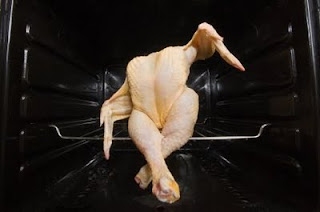You’d think that, in the weeks before the long-awaited release of Julie & Julia, every food writer and blogger in America (and beyond) was either eating funny brownies or skipping out on their meds, for all the blasting and shrieking that’s been going on. People fell into one of two camps: the pro-Julia camp (occupied largely by steadfast traditionalists who were annoyed that anyone would have the unmitigated gall to attempt a stunt — I really loathe that word — like cooking straight through all 524 recipes in Mastering the Art of French Cooking in a year) and the pro-Julie camp (occupied largely by youngish, often brash, food-obsessed bloggers with a devoted, slightly kitschy adoration of a 6’2″ culinary icon with a voice like Dick Butkus impersonating a lady; most of them can’t even remember watching Julia on television in The French Chef).
Crying Fowl: Making Julia Child’s Roast Chicken
I should say right up that I myself had a peculiar relationship with Camp Julia, both for reasons I’ve discussed publicly, and not. In 1982, when I was a sophomore at Boston University, my then-boyfriend, Chris, and I actually used to eat dinner at 4:30 in the afternoon — the minute the dining room opened — so that we could race back up to my room and watch Julia on public television, at 5. One of my most profound memories is her Buche de Noel episode; not being a baker myself, I sat agape at the physicality of it all, but that’s what often makes baking so remarkable. Chris and I yammered back and forth until Julia — if memory serves — put the tray holding the buche on the floor, underneath a broom handle that had been suspended between two chair backs. She then drizzled the liquid sugar over the handle, and it dripped onto the buche, thus replicating snow on a fallen log.
We stared at each other and honestly, I never laughed, ever again. Not even so much as a chuckle. Susan, too, took Julia so seriously that when a paperback version of one of her books came out in the late 1960s, she ran to the store and bought it with her allowance, and at 13 or 14, made her stunned parents Sole Mornay.
Anyway, this last fortnight’s shenanigans have made for some pretty interesting reading, especially when my colleague and all-around good egg, Virginia Willis, posted an extremely polite but ultimately incendiary piece on her blog: Julia and Julie: The Swap is Intentional. What was it that raised Virginia’s hackles, particularly? A very early post by Julie Powell in which she pretty much bashed Julia Child’s roast chicken recipe (page 230, for those of you who have a MAFC nearby). Giving everyone the benefit of the doubt, I went back to the original post on The Julie/Julia Project, and yes, I can see why Virginia (who was clearly brought up in a polite Southern home by polite Southern people who did not at any time bash their elders) was rankled: Julie definitely dissed the chicken, and by extension, Julia. And like I said in a previous post, you can say what you want, but don’t diss the chicken. Or Julia.
That said, I also think that Julie was just being Julie; the real Julie (as opposed to Amy Adams) is a little bit tough. She’s a little bit edgy and a tiny bit snarky. But she also seems totally unwilling to sugarcoat anything for the sake of being sweet. And that’s okay. I mean, not that I’m drawing comparisons, but can you imagine Fran Lebowitz being anything but snappish? I can’t. Anyway, I’ve pretty much come to the conclusion that ultimately, the point of Julie’s post — that Julia Child’s chicken was alright just alright, and that she preferred her own because roast chicken is such a deeply personal thing — got buried in delivery, and what came through to so many was disrespect.
But then I started to wonder: what if Julia’s roast chicken was okay, just okay? Isn’t okay-just-okay in the eye of the beholder? So, being a regular chicken roaster (or rather, a writer who roasts a lot of chickens), I decided to try to make her version myself, for dinner on Sunday night. I started at around 6 pm and we sat down to eat around 9-ish because it took me almost two hours to find our trussing needle, which Susan found buried in a drawer with Christmas-themed cheese spreaders and the Pope John Paul bottle opener that she brought home from the Vatican.
I followed the directions. Rub inside with half the butter and a little salt. Then, truss. I haven’t trussed since cooking school, and Susan and Addie, our Lab mix, watched in bewildered awe as I nearly sent the slippery bird flying down the island and across the kitchen. This is no comment on Julia; this is about the fact that I couldn’t truss my way out of a paper bag. I can tie meat really well, and a stack of newspapers on recycling day, but that’s it for me and string in the kitchen.
More butter. And then, into a roasting pan with a carrot and an onion, and then into a 425 degree F oven. But first, I had to get the chicken to sit up on its side, without falling over. Lots of luck. Susan managed to wedge it into place using the carrot and onion like wheel blocks to keep it from slipping onto its back (or its front). How did Julia do this? Honestly, I’m not sure.
There was a lot of basting; first with a mixture of oil and butter, and then with just the pan juices. There was a reduction in heat, to 350 degrees F. There was a lot of turning. This was okay: when I roast chicken, I do 20 minutes on its back, 20 minutes on its breast, 20 minutes on its back, and then let it rest for 10 before carving, and I usually wind up with a rice papery-thin, crispy, salty skin that falls apart in my mouth. So the turning thing–which seems uniquely French and which I managed to get the hang of thanks to Alice Waters’ and Patricia Wells’ recipes–works, really, really well. It’s just the resting-on-its-side part of the process that’s a little bit challenging.
Eventually, it was done. It did sputter, as Julia said it would. The kitchen smelled great. We let it rest exactly the amount of time that Julia told us to, and then I carved it. The one thing I did notice immediately was how easy it was to carve, compared to other versions I’ve made; the thigh joint popped right out, so there was no hunting around with my carving knife. I did, in fact, notice that it seemed a bit dryer than what I’m used to, and sort of fell apart while I was plating it. It was certainly not the prettiest bird I’ve ever made; that, I reserve for the tarragon-stuffed version that I make without primly sewing its little bottom shut. But in this case, the taste–buttery, incredibly rich, overwhelmingly chickeny–reminded me exactly of the chicken that my grandmother used to roast for us every Friday night when I was a kid. The skin, too, was virtually identical: it wasn’t at all crispy, but it was golden-ish, and silky, and succulently tender.
Susan and I spent dinner talking about this, and about the way food changes over the years; she grew up in a home where they didn’t touch pork unless it registered 190 degrees F on an instant-read. Today, we usually take it out of the oven at 140 degrees F and let it rest for 15 minutes or so, and a little bit of light pink doesn’t bother us too much. We don’t ever baste the chickens we roast, and the few times we’ve made guinea hen, we didn’t baste them either, and they were crispy and succulent and not at all dry. But honestly, until a few years ago, when Susan made me a roasted lemon-stuffed chicken on her father’s old patent-pending Weber grill–you just plunk it down onto the grill over indirect heat and the skin poofs away from the meat like someone’s taken an air pump to it — I had never, ever considered not basting a bird because it just wasn’t done in my home. Times and methods do change. There is always tradition, however, and I’ll bet that even those folks who shove open Budweiser cans up the backsides of their chickens sometimes go back to what they grew up with: basted, over high heat, long and slow.
It was Russell Morash, Julia’s longtime WGBH producer, who said “Julia was always forward-thinking,” and indeed, she says as much herself, in a 1978 WTTW interview with John Callaway, She was about to launch her new series, Julia & Company, and when asked by him to comment on her new venture, which was decidedly not French, she said she felt constrained and “didn’t want to be limited by tradition….Cooking is a progressive art.”
True. And somewhere in the recesses of my mind, I like to imagine Julia in Julie’s kitchen out in Queens, and Julie showing Julia how she makes her version of roast chicken. I can hear Julia now:
“Very interesting dearie. Now go make us a martini.
The traditional way.”
Previous post: A Cookie for the Big Guy
Next post: Mastering the Art of the Process: The Truth About the Dry Bird








